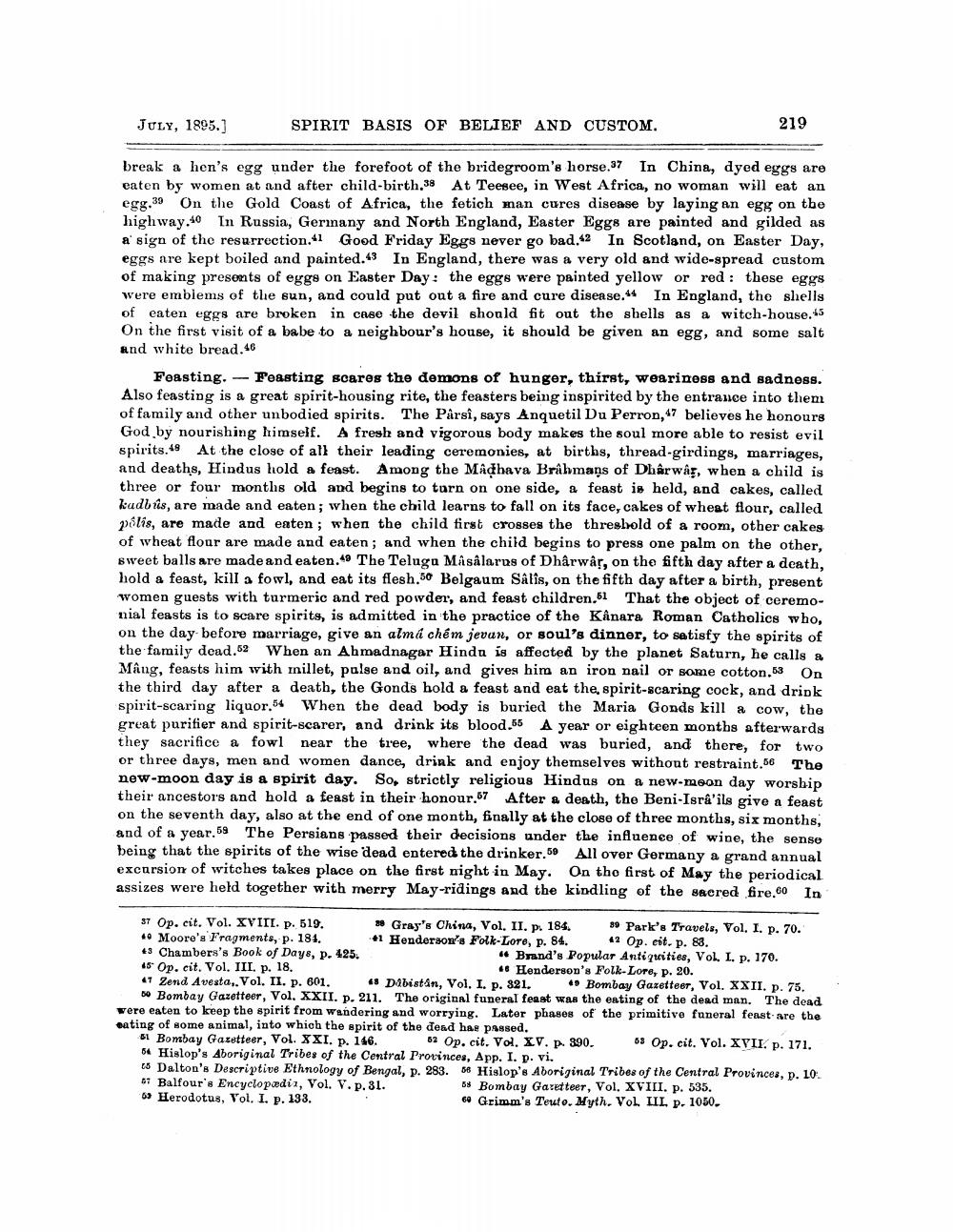________________
JULY, 1895.)
SPIRIT BASIS OF BELIEF AND CUSTOM.
219
break a hen's egg under the forefoot of the bridegroom's horse. 37 In China, dyed eggs are eaten by women at and after child-birth.38 At Teesee, in West Africa, no woman will eat an egg.39 On the Gold Coast of Africa, the fetich nan cures disease by laying an egg on the highway.40 In Russia, Gerinany and North England, Easter Eggs are painted and gilded as a sign of the resurrection.41 Good Friday Eggs never go bad.2 In Scotland, on Easter Day, eggs are kept boiled and painted.43 In England, there was a very old and wide-spread custom of making presents of eggs on Easter Day: the eggs were painted yellow or red: these eggs were emblems of the sun, and could put out a fire and cure disease.44 In England, the shells of eaten eggs are broken in case the devil should fit out the shells as a witch-house.45 On the first visit of a babe to a neighbour's house, it should be given an egg, and some salt and white bread.46
Feasting. - Feasting scares the demons of hunger, thirst, weariness and sadness. Also feasting is a great spirit-housing rite, the feasters being inspirited by the entrance into them of family and other unbodied spirits. The Pârsî, says Anquetil Du Perron, believes he honours God by nourishing himself. A fresh and vigorous body makes the soul more able to resist evil spirits. At the close of all their leading ceremonies, at births, thread-girdings, marriages, and deaths, Hindus hold a feast. Among the Maďhava Brahmans of Dharway, when a child is three or four months old and begins to turn on one side, & feast is held, and cakes, called kudhiis, are made and eaten; when the child learns to fall on its face, cakes of wheat flour, called polis, are made and eaten ; when the child first crosses the threshold of a room, other cakes of wheat flour are made and eaten; and when the child begins to press one palm on the other, sweet balls are made and eaten.49 The Teluga Masalarus of Dharwår, on the fifth day after a death, hold a feast, kill a fowl, and eat its flesh.50 Belgaum Sâlîs, on the fifth day after a birth, present women guests with turmeric and red powder, and feast children.51 That the object of ceremonial feasts is to scare spirits, is admitted in the practice of the Kânara Roman Catholics who, on the day before marriage, give an almá chém jevan, or soul's dinner, to satisfy the spirits of the family dead.52 When an Ahmadnagar Hindu is affected by the planet Saturn, he calls a Mâng, feasts him with millet, pulse and oil, and gives him an iron nail or some cotton.63 On the third day after a death, the Gonds hold a feast and eat the spirit-scaring cock, and drink spirit-scaring liquor.54 When the dead body is buried the Maria Gonds kill a cow, the great purifier and spirit-scarer, and drink its blood.55 A year or eighteen months afterwards they sacrifice a fowl near the tree, where the dead was buried, and there, for two or three days, men and women dance, drink and enjoy themselves without restraint.66 The new-moon day is a spirit day. So, strictly religious Hindus on a new-moon day worship their ancestors and hold a feast in their honour.67 After a death, the Beni-Isra'ils give a feast on the seventh day, also at the end of one month, finally at the close of three months, six months, and of a year.59 The Persians passed their decisions under the influence of wine, the sense being that the spirits of the wise dead entered the drinker.50 All over Germany a grand annual excursion of witches takes place on the first night in May. On the first of May the periodical assizes were held together with merry May-ridings and the kindling of the sacred fire.co In
37 Op. cit. Vol. XVIII. p. 519.
Gray's China, Vol. II. p. 184. 80 Park's Travels, Vol. I. p. 70. 40 Moore's Fragments, p. 184. +1 Henderson'Folk-Lore, p. 84. 42 Op. cit. p. 83. 43 Chambers's Book of Days, p. 425.
Brand's Popular Antiquities, Vol. I. p. 170. 15* Op. cit. Vol. III. p. 18.
46 Henderson's Folk Lore, p. 20. 47 Zend Avesta, Vol. II. p. 601. 48 Dibistan, Vol. I. p. 321. "Bombay Gazetteer, Vol. XXII. p. 75.
00 Bombay Gazetteer, Vol. XXII. p. 211. The original funeral feast was the eating of the dead man. The dead were eaten to keep the spirit from wandering and worrying. Later phases of the primitive funeral feast are the eating of some animal, into which the spirit of the dead has passed.
61 Bombay Gazetteer, Vol. XXI. p. 146. 62 Op. cit. Vol. XV. p. 390. 63 Op. cit. Vol. XVII. p. 171. 64 Hislop's Aboriginal Tribes of the Central Provinces, App. I. p. vi. 05 Dalton's Descriptive Ethnology of Bengal, p. 283.68 Hislop's Aboriginal Tribes of the Central Provinces, D. LO. 67 Balfour's Encyclopædia, Vol. V. p.31.
5% Bombay Gazetteer, Vol. XVIII. p. 535. 65 Herodotus, Vol. I, p. 133.
60 Grimm's Teuto. Myth. VOL. IIL P. 1050.




